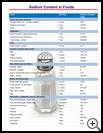
Hyponatremia (Low Sodium)
________________________________________________________________________
KEY POINTS
- Hyponatremia means that the amount of sodium in your child’s blood is lower than normal. Sodium is one of several minerals in the blood called electrolytes. Electrolytes help control the amount of water in your child’s body and the way your child’s muscles, nerves, and other cells work. Your child needs the right balance of water, sodium and other electrolytes in the body to stay healthy.
- Treatment will depend on how low the sodium level is and the cause. Your child’s healthcare provider may change or add a medicine or limit the amount of liquids your child drinks to increase your child’s sodium level.
- Follow your child’s healthcare provider's instructions. Check with your child’s healthcare provider before you change your child’s diet. Getting too much sodium can cause serious and life-threatening problems.
________________________________________________________________________
What is a low sodium level?
Hyponatremia means that the amount of sodium in your child’s blood is lower than normal. Sodium is one of several minerals in the blood called electrolytes. Electrolytes help control the amount of water in your child’s body and the way your child’s muscles, nerves, and other cells work. Your child needs the right balance of water, sodium and other electrolytes in the body to stay healthy.
The balance of electrolytes in your child’s body is affected by food, medicine, and how much water your child drinks. Your child’s lungs, kidneys, and other organs help balance electrolytes and water.
Your child gets sodium from food and drinks. Salt is often the main source of sodium in your child’s diet.
What is the cause?
A low sodium level usually happens when your child does not have the right balance of sodium and water in the body. The risk is higher if your child:
- Exercises a lot and sweats a lot, such as when running a marathon
- Vomits, has diarrhea, or has a high fever for more than a short time
- Drinks a lot more water than usual
- Has a bad burn
- Has heart, kidney, or adrenal gland problems, or cystic fibrosis
- Has a head injury
- Takes certain medicines or illegal drugs that affect fluids and electrolytes
- Has a high blood glucose (sugar) level, which affects the sodium level
What are the symptoms?
Your child may not have symptoms until the sodium level drops too low or too fast.
Symptoms may include:
- Poor appetite
- Nausea and vomiting
- Very dry mouth
- Tiredness or sleepiness
- Weak muscles or muscle cramps
- Rapid heart rate
More serious symptoms can include:
- Shortness of breath, especially if there is too much fluid in the body
- Confusion
- Seizures
- Coma
How is it diagnosed?
Your child’s healthcare provider will ask about your child’s symptoms and medical history and examine your child. Your child may have blood and urine tests to measure sodium and other electrolyte levels.
How is it treated?
Treatment will depend on how low the sodium level is and the cause.
- For loss of fluid caused by stomach flu or heavy exercise, drinking an oral rehydration solution (ORS) will help replace water, sodium, and other electrolytes.
- If your child’s sodium level is very low, your child will probably stay in the hospital and get fluids and electrolytes by IV.
- If low sodium is caused by a medical problem such as kidney disease, treating the medical problem may improve your child’s sodium level.
- If the low sodium was caused by medicines such as water pills (diuretics), your child’s healthcare provider may change the medicine or the dose and may advise you to limit the amount of liquids your child drinks.
- Your child may have blood tests regularly to check the sodium level.
How should I take care of my child?
Follow your healthcare provider's instructions. Check with your child’s healthcare provider before you change your child’s diet. Getting too much sodium can cause serious and life-threatening problems.
You may need to meet with a dietitian to learn how much sodium and liquids your child needs for a healthy diet.
Ask your child’s healthcare provider:
- How and when you will get your child’s test results
- How long it will take to recover
- If there are activities your child should avoid and when your child can return to normal activities
- How to take care of your child at home
- What symptoms or problems you should watch for and what to do if your child has them
Make sure you know when your child should come back for a checkup. Don’t miss checkups or lab tests.
How can I help prevent my child from having a low sodium level?
If your child gets a lot of exercise or has had the stomach flu, sports drinks or ORS drinks can help prevent dehydration and a low sodium level.
For babies and children who have had vomiting or diarrhea, call your healthcare provider for advice about ORS.
Call your healthcare provider right away if your child has vomiting or has had a lot of diarrhea, or if your child is taking diuretics and has symptoms of a low sodium level.
Last modified: 2019-02-20
Last reviewed: 2019-01-03

